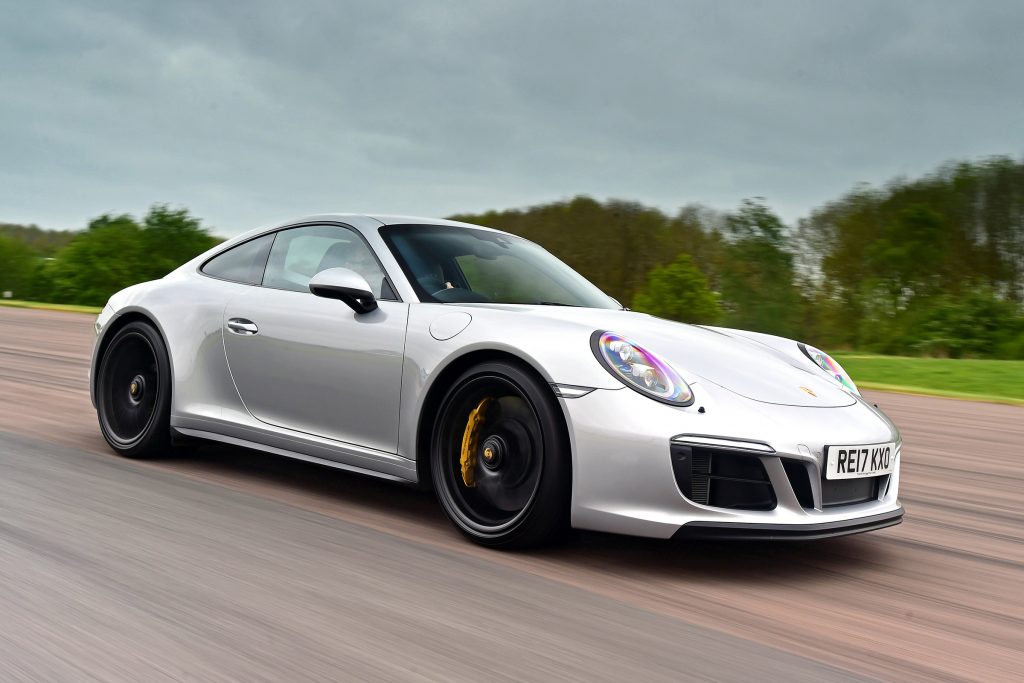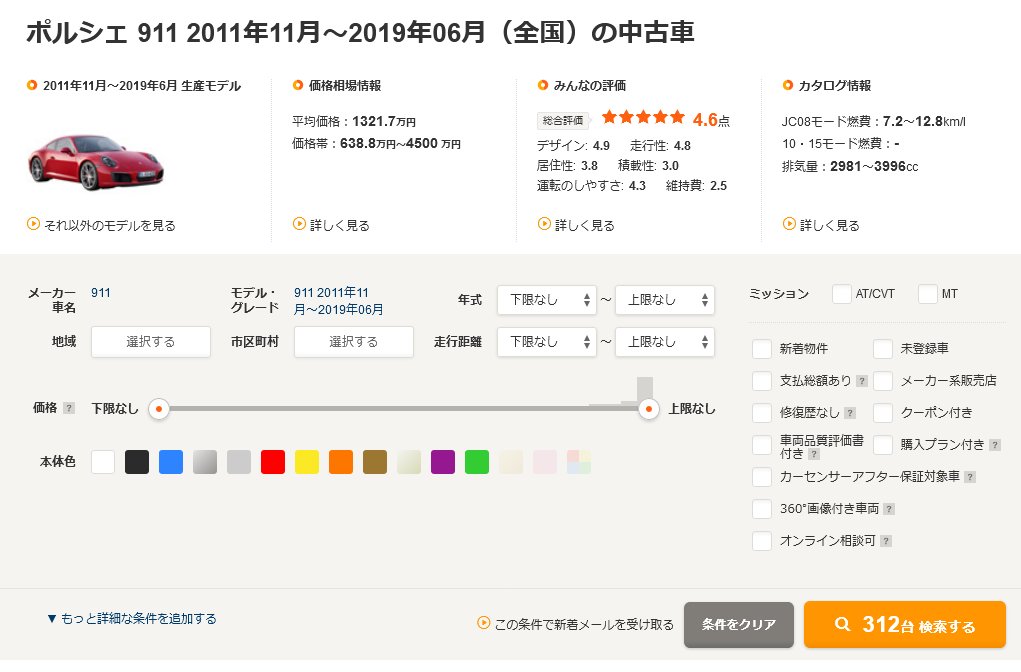997型と比べると見た目以上に大きな変化がある

引用元:seecolor
現行型ポルシェ911の一世代前のモデルである991型ポルシェ911について書いていこうと思います。
まず、外観だけを見ると997型と比較してそれほど大きく変わった印象はありませんが、ドアミラーがAピラーの付け根からドアスキンマウントに変更になっていますね。
ミラーの形状も変わっているので、空力的な改善を目的にドアミラーの位置が変更になっているのかもしれませんが、これによって「死角」が少なくなるメリットは結構大きいんじゃないかと思います。
また、プラットフォームに軽量素材を使用することで剛性を高めながらもかなりの軽量化が行われているようです。
比較が少し強引ですが、重い荷物を載せたトラックと、普通の乗用車を乗り比べたとき、加速はもちろんですがブレーキを踏んだときやコーナリング時の安定感は全く異なり、重量が軽いほうが車は機敏な動きをするわけで、運動性能を追及するポルシェ911にとって軽量化は性能アップにダイレクトに繋がる大きなポイントになりますね。
もちろんエンジンにも改良が加えられていて、出力アップしながらも燃費性能は更に向上しており、ここはさすがポルシェといったところです。
991型ポルシェ911の中古車は300台以上!

そんな991型ポルシェ911の中古車を検索してみると、なんと300台以上の登録がありました。
997型が約180台だったので、その約1.7倍もの991型ポルシェ911がカーセンサー上に登録されていることになります。
これは前期型、後期型すべてのモデルを合計したものですが、後期型が登場した2015年以降に絞って検索した場合で200台以上の登録がありましたので、前期型は約100台ということになり、後期型(2015年で設定したので前期型も少し含まれているのですが)のほうが圧倒的に多いという結果になりました。
そんな300台以上ある中古車の中から僕が購入の条件として考えている「右ハンドル」+「AT」で絞込みを行うと、結果は111台。
996型、997型に比べるとかなり選択肢は増えました。
価格を見てみると最低でも800万円からのスタートで、低走行のものだと前期型でも900万円台、後期型に関しては950万円以上でやっと登場し、概ね1000万円以上となっています。
正直、この価格だけを見ると普通のサラリーマンが手を出せる価格帯ではなくなっており、改めて997型などを見てみると「安い」と錯覚してしまうほどの価格です。(997型もけっして安いわけではないです)
ただ、購入価格は高くなりますが、売却時の価格も高くなると考えると、貯金をするつもりで毎月の支払いを頑張れば、最後にはある程度のまとまったお金が残り、次の車の購入資金になるんじゃないかと考えてみたりもします。
とは言うものの、自分のペースでできる貯金と、ローンの支払いでは同じ金額であっても感じるプレッシャーは天と地で、そのプレッシャーに耐えながらポルシェ911を所有するのが果たして幸せなのか?そんな思いもありますが、そのあたりはもう少しゆっくり考えてみようと思います。
991型ポルシェ911、後期型では全てのカレラがターボ化されている
991後期型が登場したのが今から約6年前の2015年ですが、それ以前からも地球を取り巻く環境問題への取り組みが活発化しており、自動車の排出ガス規制も日を追うごとに厳しくなり、自動車メーカーはその対応に多くのコストを掛けています。
そんな中で起こったのが「ディーゼルゲート事件」ですが、そんな不正を犯してまでクリアしなければならないほど排出ガスの規制はどんどん厳しくなるばかりで、当時の規制をクリアするために991後期型では「ダウンサイジングターボ」エンジンが搭載されることとなります。
一部の911ファンの間ではこの「ターボ化」は不評だという話を聞いたこともありますが、ここでもポルシェは環境規制に対応しながらもパワーアップ、そして燃費向上を成し遂げているわけで、その技術の追求に関しては純粋に凄いの一言です。
ターボ化についてはフェラーリがターボエンジンを採用した際にも「反対派」は少なからずいたようですが、世の中の流れに対応し、会社を存続させるためには避けて通れない道で、これからさらに「ハイブリッド化」、そして「EV」へと変化していくことになるのでしょうね。
ここでひとつ思うのが、今では水冷が当たり前となったポルシェですが、水冷化される前の空冷ポルシェの価格は高騰しており、もしかするとそれと同じようにターボ化される前の「自然吸気のポルシェ」の価値がどんどん上がることになるんじゃないかということで、それなら「自然吸気」の991前期型や996型、997型を狙うのもありなんじゃないかと考えています。
Type 991 is the new generation of Porsche 911
Compared to the Model 997, there are more significant changes than meets the eye.

Cited from: seecolor
I would like to write about the 991 Porsche 911, which is the model one generation before the current Porsche 911.
First of all, if you look only at the appearance, there is no impression that has changed so much compared to the 997 model, but the door mirror has been changed from the base of the A pillar to the door skin mount.
The shape of the mirrors has also changed, so the position of the door mirrors may have been changed for the purpose of improving aerodynamics, but I think the benefit of reducing the "blind spot" is quite large.
Also, the use of lightweight materials in the platform seems to have reduced the weight considerably while increasing rigidity.
The comparison is a bit forced, but when you compare a truck with a heavy load and a normal passenger car, the stability when braking and cornering is completely different, not to mention the acceleration, and the lighter the weight, the more agile the car moves, and for the Porsche 911 to pursue athletic performance, weight reduction is a big point that leads directly to performance improvement. It is a big point that leads directly to the performance increase.
Of course, improvements have also been made to the engine, fuel efficiency has been further improved while increasing the output, and this is where Porsche comes in.
There are over 300 used 991 Porsche 911's out there!

When I searched for used cars of such 991 Porsche 911, I found that there were more than 300 registered.
Since the 997 model was about 180 units, it means that about 1.7 times as many 991 Porsche 911s have been registered on Car Sensor.
This is the total of all the models of the early and late models, but when the search was narrowed down to 2015 when the late model appeared, there were more than 200 registrations, which means that the early model is about 100 units, and the late model (although the early model is also included a little because it was set in 2015) is by far the most common. The result is that the number of late models (which includes a few early models since it was set up in 2015) is much larger.
When I narrowed down my search from more than 300 used cars by "right-hand drive" + "AT", which I consider as a condition for purchase, the result was 111 cars.
Compared to the 996 and 997 models, the number of choices has increased considerably.
If you look at the price, it starts from 8 million yen at least, and if it's a low-running one, it's in the 9 million yen range even for the early model, and for the late model, it finally appears at more than 9.5 million yen, and generally it's more than 10 million yen.
To be honest, if you look at this price alone, it is no longer a price range that an ordinary businessman can afford, and if you look at the 997 model again, the price is so low that it gives the illusion of "cheap". (The 997 model is not cheap either.)
However, when you consider that the purchase price will be higher, but the price at the time of sale will also be higher, if you work hard to make monthly payments with the intention of saving money, at the end of the day, you will have a certain amount of money left over, which you can use to purchase your next car.
However, the pressure that I feel is heaven and earth, even if it is the same amount of money for the loan payment and the savings that I can do at my own pace, is it really happy to own a Porsche 911 while enduring that pressure? I have such thoughts, but I will think about it more slowly.
Type 991 Porsche 911, all Carreras are turbocharged in the later models.
The late 991 model was introduced in 2015, about six years ago, but even before that, efforts to deal with environmental issues surrounding the earth have been intensifying, and automobile emission regulations are becoming stricter with each passing day, and automakers are spending a lot of money to deal with them.
The "Dieselgate incident" happened in such a situation, but the emission regulations were only getting stricter and stricter to the extent that they had to be cleared by committing such fraud, and in order to clear the regulations at that time, the 991 late model was equipped with a "downsizing turbo" engine.
I have heard that this "turbocharging" is not popular among some 911 fans, but Porsche has achieved power increase and fuel efficiency improvement while complying with environmental regulations, and the pursuit of this technology is purely amazing.
As for turbocharging, it seems that there were not a few "opponents" even when Ferrari adopted turbocharged engines, but it is a path that cannot be avoided in order to respond to the trends of the world and to keep the company alive, and it will probably change to "hybridization" and "EV" in the future.
One thing I think here is that although water-cooling is now the norm for Porsches, the price of air-cooled Porsches before water-cooling has skyrocketed, and perhaps the value of "naturally-aspirated Porsches" before turbocharging will go up and up in the same way. I think it is possible to go for the early 991, 996 and 997 models.
Translated with www.DeepL.com

























